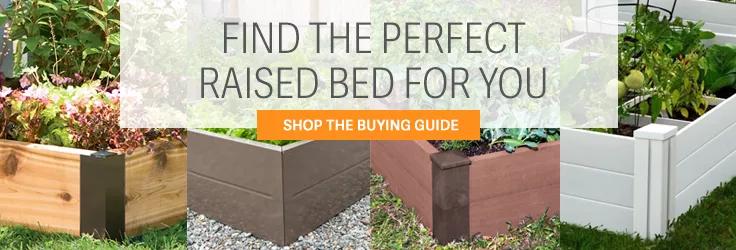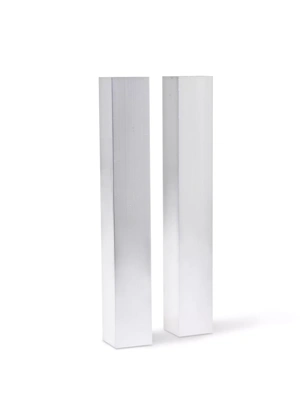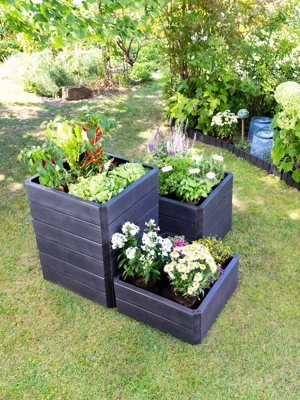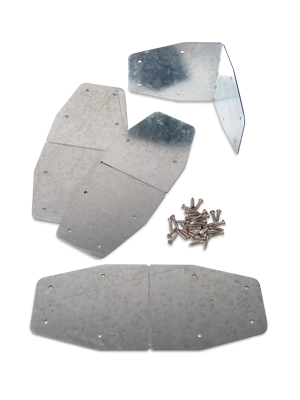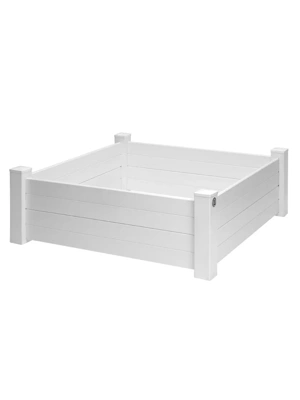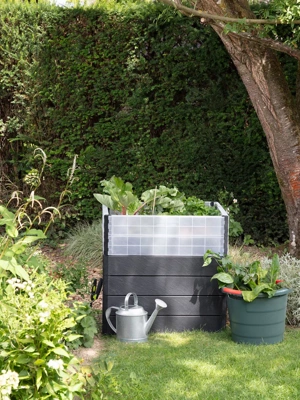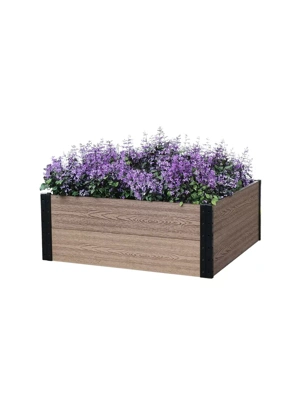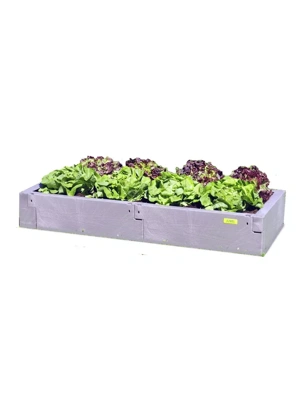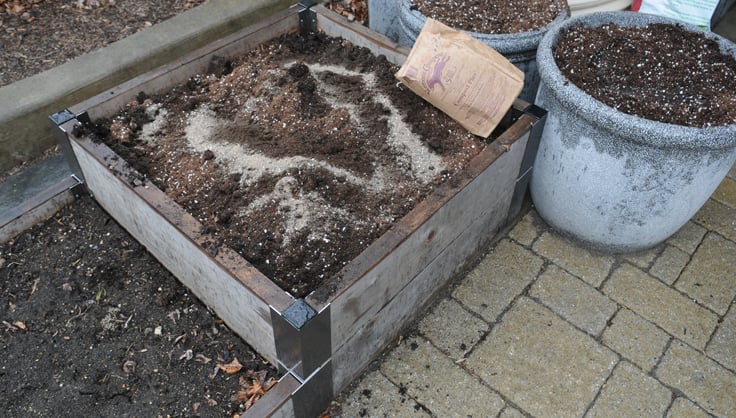Everything You Need to Know About Gardening in Raised Beds
How to choose, prep, and tend your raised bed garden.
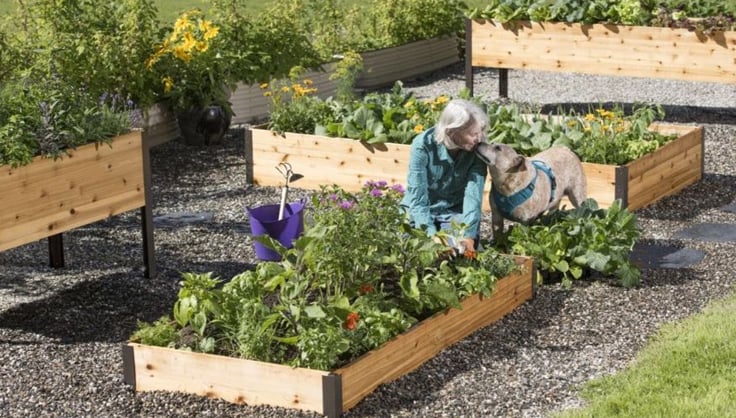 This kitchen garden is DIY, made with our raised garden bed kits.
This kitchen garden is DIY, made with our raised garden bed kits.In this Article
Starting a new garden? Or revamping your current garden setup? Consider growing in a raised bed (or 3) this season!
Here's why we love growing in raised bed gardens:
1. Longer growing season. Compared to in-ground beds, raised bed soil warms AND drains faster in the spring, so gardeners get a few extra weeks of growing.
2. Better soil. It's easy to amend the soil to meet your particular growing needs.
3. Bigger harvests. Intensive planting and vertical supports lead to a more productive garden.
4. No competition. A defined growing space means weeds, pets, and kids stay out of the garden!
5. Healthier soil. Since it's not being compacted by foot traffic, the soil stays fluffy and aerated.
6. Easy access. Elevated raised beds and planters bring the garden right up to you; no bending is needed.
7. Garden anywhere. The HUGE range of raised bed materials, styles, and sizes means you can grow anywhere — over heavy clay soils, in front of the ugly fence, and right on the deck.
8. Plant protection. Row fabrics, covers, and cloches protect your plants from pests and weather and are incredibly easy to install on a raised bed.
Choosing a Raised Bed for Your Garden
Gardener's Supply offers a wide range of raised beds, from DIY-style raised beds, to complete kits for beds made of cedar, composite wood, recycled plastic, and galvanized steel. You can also consider elevated raised beds for no-bend gardening.
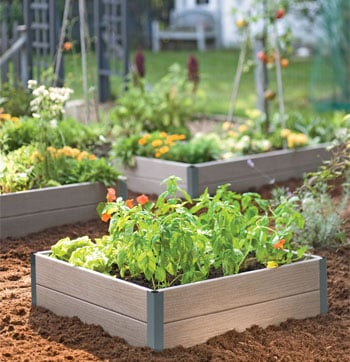 Our Sustainable Raised Beds can be set up in minutes and last for decades. Made from a composite of recycled wood and plastic, they have the attractive look and feel of silvery aged cedar but will never splinter or rot.
Our Sustainable Raised Beds can be set up in minutes and last for decades. Made from a composite of recycled wood and plastic, they have the attractive look and feel of silvery aged cedar but will never splinter or rot.Raised beds range in height, starting at about 6". In general, the more soil depth that's available to your plants, the more freely their roots will grow. More soil also holds more moisture, so a deeper raised bed will require less frequent watering.
It is possible to install a raised bed on poor or compacted soil or even on concrete. If this is the situation you have, buy the deepest bed you can afford. A depth of 10-12" is preferable. Keep in mind that the deeper the bed, the more soil you'll need to fill it. Use the Soil Calculator to determine how much soil you'll need.
How many raised beds should you have? If your space or time is limited, you might want to start out with just one. If you're trying to produce lots of your own fresh vegetables, you will probably need at least three or four beds. Use the Kitchen Garden Planner, our free online garden design tool, to select and place the crops you want to have in each bed. This will help you determine how many total beds you'll need to accommodate everything you want to grow.
Siting and Filling a Raised Bed Garden
Your raised bed is assembled, and you are excited to get some plants in the ground! We know this feeling all too well. BUT — spend a little effort up front preparing and properly siting your raised bed so you can reap garden rewards later. A few dos and dont's to consider when choosing a location for your raised bed:
DO look for the light. Most of our herbs, veggies, and annual flowers appreciate plenty of sun, so select a raised bed site that receives approximately 8 hours of sunlight per day. The more sun, the better. Live on the shady side of the street? Don't fret! There are plenty of plants that thrive in partial shade, including arugula, parsley, spearmint, chives, and violas (pansies). Take time to research individual plants and plants that will thrive in your microclimate.
DON’T install your raised bed in a wet area. Raised beds need to drain well so your garden soil isn’t continuously soggy. Avoid those low, wet spots on the property. Better yet, plant a few moisture-loving native plants there instead.
DO consider the proximity of your water source! Because your garden will need to be watered during the growing season, you'll want to have relatively easy access to a hose. Soaker hoses and drip irrigation systems dribble water slowly into the ground right at soil level and are a very efficient way to the water.
DON’T skimp on the soil! High-quality, nutrient-rich soil is a must for any and all gardens. Raised beds give you an immediate advantage over an in-ground garden because when you fill your raised bed, you can fill it with a blend of soil that's superior to the native soil in your yard. Familiarize yourself with some common soil and fertilizer terminology and make any necessary amendments to the soil texture, pH, or drainage. As always, compost is your garden's best friend — start churning out your own, or get your hands on a bag of ready-made compost mix to add to your new garden.
Raised Bed Soil
Speaking of soil, what kind should I use in my raised bed? How much? If you are brand new to gardening or filling a single bed on the smaller side, keep it simple — use a pre-mixed bag of raised bed mix that has compost and organic matter already blended in. If you plan to fill more than one raised bed, you may want to buy your soil components in bulk — by the cubic foot or cubic yard — and mix yourself.
If you plan to buy topsoil in bulk, go to a reputable garden center or nursery and ask for information on the origin of the soil. Examine the soil before shoveling it into your new raised bed. Topsoil should be dark and crumbly with an earthy smell. Do not purchase soil that is very high in clay, has a funky odor, or feels sticky in texture. Generally speaking, aim for the following ratio of soil components:
Raised Bed Soil "Recipe" = 50-60% topsoil + 40-50% compost
How deep should your beds be? Leafy greens and herbs need at least 6 inches of growing depth, while tomatoes, squash, and other deep-root crops require at least 12-18 inches of nutrient-rich soil. That being said, plants will almost always appreciate deeper soils, which encourage stronger, sturdier roots. If you are building your raised bed over grass or bare earth, you can gain additional soil depth by digging 6-12 inches down into the earth, removing any large rocks and debris, and mixing in some of your raised bed soil.
Blending in additional organic matter, such as leaf mold, will further enhance soil microbial life and improve moisture retention in your garden bed. If you are planning to grow any specialty crops that might benefit from additional nutrients or adjusted chemistry, add any necessary soil amendments to your raised bed. Blueberries, for example, may appreciate an acidifier.
Planting in Raised Beds
Grow things that bring you joy and that you'll look forward to watering, weeding, and harvesting all season long! Do you love to cook? Give potatoes, leeks, and herbs a try. Are you interested in cutting flowers for DIY bouquets? Try zinnias, sunflowers, and cosmos. Grow a dye garden one year and maybe plant a cocktail garden the next.
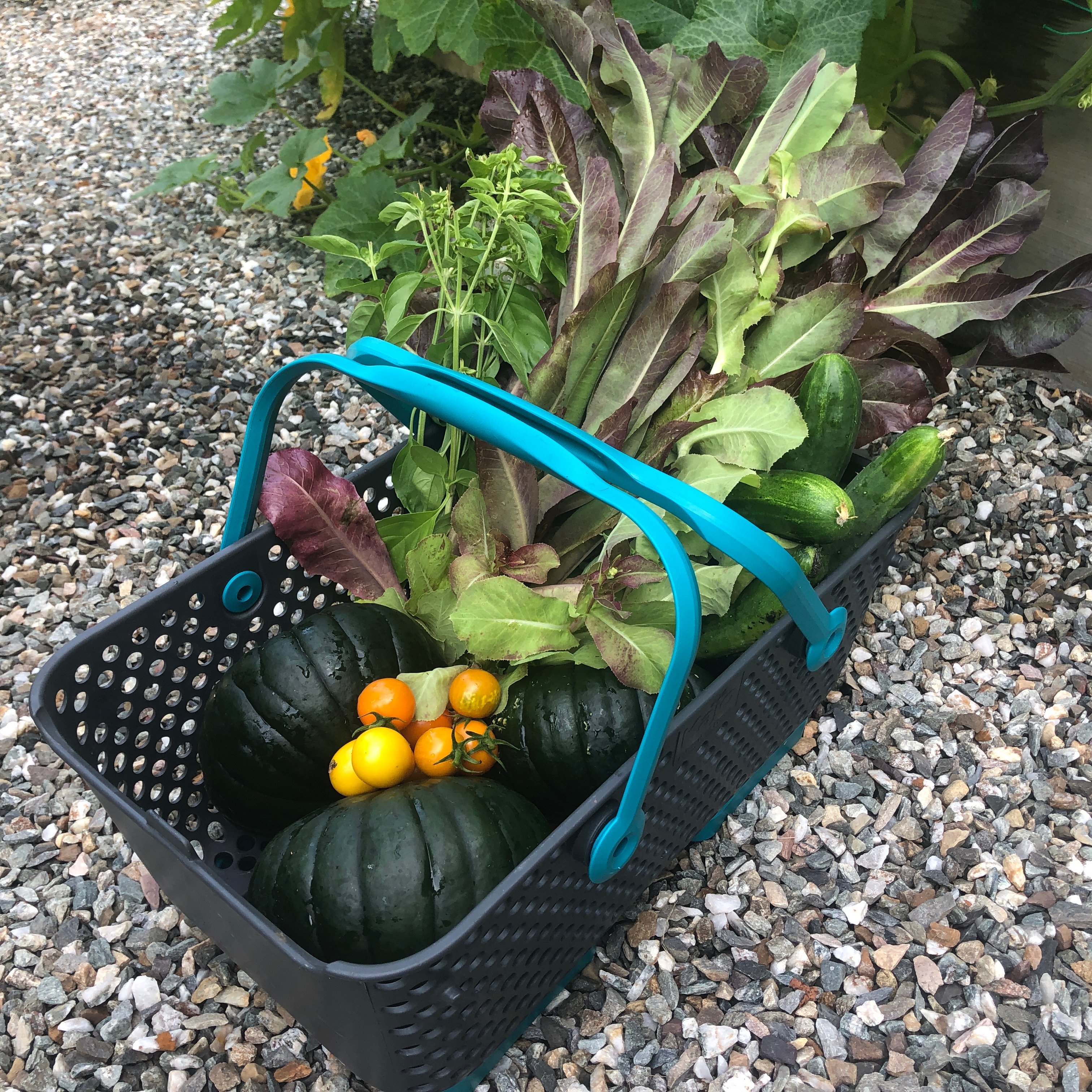 Choose vegetables that you like to eat — or try something that's new to you.
Choose vegetables that you like to eat — or try something that's new to you.Raised beds are meant to be planted intensively. Keeping plants close together helps to retain soil moisture and minimize open space for prospective weeds. The challenge is to grow as much food as possible while resisting the temptation to squeeze in too many plants. Overcrowded plants never reach their full potential because they're stressed by poor air circulation and competition for nutrients and root space.
Seeding
Starting your garden from seed gives you the opportunity to try new and fun (and sometimes obscure!) varieties of plants. Vegetables that can be sown directly into the garden from seed include root crops, such as carrots and beets, as well as beans, peas, corn, cucumbers, and squash. In some cases, these crops are direct-sown because they do not transplant well, and it's best to sow the seeds right where they're going to grow.
Soil temperature is an important planting-time consideration. Most plants thrive in a moderate soil temperature of 60 to 70 degrees F. Some, such as peas and spinach, will germinate well and grow just fine in cool (45 degrees F.) soil. Others, such as eggplant and melons, will not germinate, nor will they grow properly unless the soil is above 60 degrees F.
Row Seeding: Garden rows can organize your crops and make for easy and efficient weeding and harvesting. If you’re growing for market, planting in rows at specific intervals can help you estimate your overall garden yield. A few tips on establishing garden rows:
- Use a small trowel or other hand tool to create a shallow furrow (very small trench) that runs the length of your raised bed.
- Check the back of your seed packet to get an idea of how much space each plant will require, and then use a seed spacing ruler or dibber to accurately space your seeds along the furrow. Radishes may be perfectly content 4 inches apart, but some varieties of tomatoes need at least 2 feet of space!
Broadcast Seeding: Broadcast or block seeding is all about maximizing planting efficiency and is especially helpful for covering larger garden spaces. Simply scrape the top inch of garden soil off to the side of your raised bed, sprinkle your seeds in the planting area, and then gently toss the soil back over them. Leafy greens, basil, carrots, radishes, and other small-seeded plants are excellent candidates for broadcast seeding. As your seeds germinate, thin and toss in the compost — or better yet, eat!
Transplanting
Though most of the vegetables you'll want to grow could be started directly in the garden from seed, in many cases, it's best to start out with a plant. Transplanting shortens the time to harvest by a month or more. In cold regions, where the growing season may be 100 days (or less!), a tomato or pepper plant that's started in the garden from seed will not have time to mature before frost arrives in the fall. Check your local garden center or farmstand for seedlings that you can transplant right into your raised bed.
Tending Your Raised Bed Garden
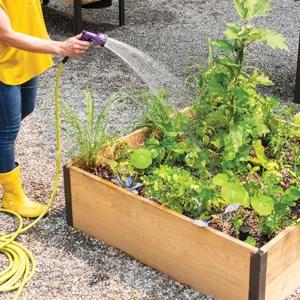
Watering a Raised Bed
In a perfect world, Mother Nature would provide an inch of rain each week to keep our vegetables and flowers perfectly happy. As an ever-changing climate makes it harder to predict seasonal rains, it's up to us to make sure our plants get the water they need to thrive! Raised bed soil doesn’t dry out quite as fast as in-ground garden soil; the sides of the bed help retain moisture, and the closely planted plants shade the soil to reduce evaporation.
The best way to monitor soil moisture is with your hands. When you stick a finger down into the soil, it should feel lightly damp — like a sponge that has been wrung out. Don't just poke at the surface; get your fingers down to the root zone (3" deep or so) at least once a week. Going on vacation in August? Acquire a water timer to automatically turn on a sprinkler or soaker hose so you don’t come home to fried garden crops.
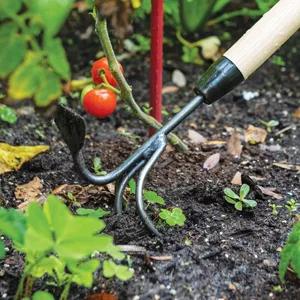
Weeding a Raised Bed
When planted intensively, raised beds to help keep weeds to a minimum. When weeds do pop up, you'll want to remove them quickly so your garden crops aren't competing for moisture, nutrients, and root space. You're growing your food here, so stick to physical weed removal and don't apply herbicide!

Fertilizing a Raised Bed
Having a healthy soil chock full of composted organic matter from Day 1 will serve you well no matter what or where you’re growing. However, veggies and annual flowers can be heavy feeders, and crops that take three or four months to mature usually benefit from a midseason application of fertilizer. If you are succession planting (removing spent plants and popping in a new or different batch), be sure to add a healthy dose of slow-release, organic fertilizer between crops.

Supporting Plants in a Raised Bed
Some plants, including pole beans and most tomatoes, need a cage, trellis, or another type of support to grow properly and produce a good crop. Sturdy structures help prevent overloaded stems from snapping off and increase air circulation between leaves, minimizing disease spread between plants. Growing vertically with the aid of plant supports helps keep the garden neat and makes it easier to access plants for harvesting. It's important to consider how each plant's growth habit (bushy, climbing, trailing) will affect its neighbors in the same bed. Planting lettuce next to carrots is fine; planting lettuce next to a sprawling cucumber plant may be a problem.

Protecting Your Raised Bed Garden
Unseasonal cold snaps, hungry cabbage worms, searing sunshine, destructive vine borers, angry birds, early fall frosts — it's a wonder we manage to harvest anything at all! Luckily there are a host of different plant protectors and row covers that are incredibly easy to install over a raised bed. If possible, young seedlings should be transplanted into the garden when the weather is calm, cool, and drizzly. Tender seedlings will suffer if they're planted out on a hot or windy day. If the weather doesn't cooperate, water your new seedlings thoroughly after planting and then cover them with garden fabric for several days. The plants need time to establish new roots before they are able to extract moisture and nutrients from the soil.
Our gardening friend Laura, from Garden Answer, walks viewers through the basics of raised beds, from soils to fertilizers to watering. Now get your raised bed going and your garden growing!
Last updated: 03/21/2024
Print this Article:
Related items
Related Articles
Get the Dirt
Stay up to date on new articles and advice. Please fill out the information below.

